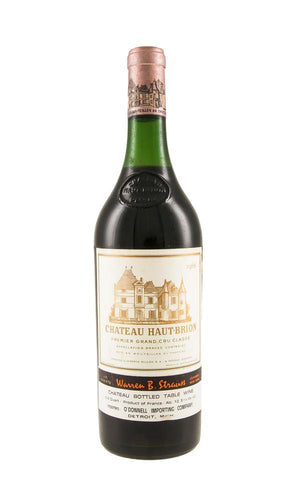- Our Shop

$1,298.99
Closed at first, the 1966 then opens with those disarming lanolin and wax resin scents, albeit without the delineation of previous bottles. The palate offers notes of dried pineapple, quite saline in the mouth, with strong and powerful honeyed notes towards the finish.
Order from the Largest & Most Trusted Premium Spirits Marketplace!
Featured in
NOTICE: Many other small liquor store sites may end up cancelling your order due to the high demand, unavailability or inaccurate inventory counts. We have partnerships consisting of a large network of licensed retailers from within the United States, Europe and across the world ensuring orders are fulfilled.
Producer: Ch√¢teau Haut-Brion
Ratings: V | 93 JG | 92
Vintage: 1966
Size: 750ml
ABV: 12%
Varietal: Bordeaux Blend Red
Country/Region: France, Bordeaux
Closed at first, the 1966 then opens with those disarming lanolin and wax resin scents, albeit without the delineation of previous bottles. The palate offers notes of dried pineapple, quite saline in the mouth, with strong and powerful honeyed notes towards the finish.
Reviews:
Ch√¢teau Haut-Brion is the oldest of Bordeaux’s five first growths, and one of the most famous wines in the world. Located in Pessac-L√©ognan, south of the city of Bordeaux, the ch√¢teau is rather far removed from its counterparts, all of which are found in the M√©doc. Lafite Rothschild, Mouton Rothschild and Latour are all in Pauillac, while Ch√¢teau Margaux is ‚Äì unsurprisingly ‚Äì in Margaux. The property is in the northern Graves on the outskirts of Bordeaux, and is now surrounded by encroaching buildings and roads. It is also flanked by La Mission Haut-Brion, which was bought by Haut-Brion’s owners in the early 1980s. The majority of the estate’s 51 hectares (126 acres) of vineyard is planted to red varieties with Merlot, Cabernet Sauvignon, Cabernet Franc and Petit Verdot covering 48 hectares (118 acres) while three hectares (7.5 acres) are given over to Sauvignon Blanc and S√©millon. The Haut-Brion cuv√©e tends to have more Merlot than the wines from the Medoc, with Cabernet Sauvignon in more of a supporting role (this is reflected in the vineyard). As such, Haut-Brion is more rounded and softer than other Left Bank wines. The ch√¢teau describes the wine as having an empyreumatic (charred organic matter) bouquet. The ch√¢teau’s second wine has been known as La Clarence de Haut-Brion since 2007.
Only logged in customers who have purchased this product may leave a review.
Bourbon Bridges Ltd ©2024 Privacy Policy

THE ALCOHOL PRODUCTS ON THIS WEBSITE ARE INTENDED FOR ADULTS ONLY.
By entering this website, you certify that you are of legal drinking age in the location in which you reside (age 21+ in the United States).
Reviews
There are no reviews yet.